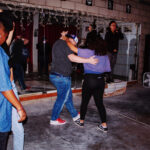We’ve all heard the advice: “feel your feelings.” Easy to say, much harder to do, right? Especially when those feelings are uncomfortable and society often encourages us to bottle them up. But what if there was a joyful, energizing way to connect with your emotions? That’s where dance comes in, and even better, dancing to music that truly moves you. Let’s dive into why incorporating dance with Good Music To Dance To is an essential form of movement to help you process and feel everything you need to.
Why Tune In To Your Emotions?
A significant part of working on our well-being involves undoing the societal programming that teaches us to repress emotions. Learning to acknowledge and identify what we’re feeling is a crucial first step in trusting our bodies again. Emotions arise from events – physical, emotional, or mental triggers – and understanding this cycle is key.
Imagine this: someone playfully pokes you. You might feel the physical sensation, a flash of surprise, or even a sense of annoyance. A natural, healthy response might be to say, “Hey!” – acknowledging the sensation. However, often we don’t fully express the layers of emotion beneath the surface, like the surprise or slight irritation in this example. When we consistently suppress these emotional expressions, our bodies learn to hold onto them, potentially leading to various physical and mental manifestations.
The Body’s Silent Signals: What Happens When Emotions Are Held Back?
Unexpressed emotions can manifest in surprising ways:
- Increased Anxiety
- Feelings of Depression
- Chronic Stress
- Muscle Tension and Unexplained Pain
- Digestive Issues and Nausea
- Changes in Appetite
- Persistent Fatigue and Sleep Disturbances
Identifying and acknowledging emotions is only part of the process. Our bodies also need a way to release them. Think of it as a complete emotional response cycle: (1) an event occurs, (2) we identify the feeling, (3) we express it verbally, and (4) crucially, we need a physical outlet to fully integrate the experience. This is where dance, especially when paired with good music to dance to, becomes incredibly powerful. Dance provides an intuitive way for the body to move, flow, and release held emotions, offering profound benefits for our mental health.
The Rhythm Within: Mental Health Benefits of Dancing to Music
Dancing, especially to music you love, isn’t just fun – it’s deeply beneficial for your mental well-being:
- Emotional Release: Movement naturally helps release pent-up emotions, and music amplifies this effect, acting as a catalyst for emotional expression.
- Stress Reduction: Dancing is a fantastic stress reliever. The combination of physical activity and engaging with good music to dance to lowers cortisol levels and promotes relaxation.
- Mood Booster: Upbeat music and rhythmic movement stimulate the release of endorphins, natural mood elevators that combat feelings of sadness or low energy.
- Increased Body Awareness: Dancing encourages you to connect with your body, fostering a greater understanding of your physical and emotional state.
- Improved Self-Esteem: Expressing yourself through dance can boost confidence and self-esteem as you become more comfortable in your body.
- Enhanced Creativity: Moving freely to music can unlock creativity and provide a new avenue for self-expression beyond words.
These benefits highlight why incorporating dance with good music to dance to can be so valuable for your emotional and mental health. Try dancing after a therapy session, after a disagreement, during a stressful workday, or simply to uplift your mood. Pay attention to how you feel before and after your dance session. You might be surprised at the positive shift that movement and music can create.


